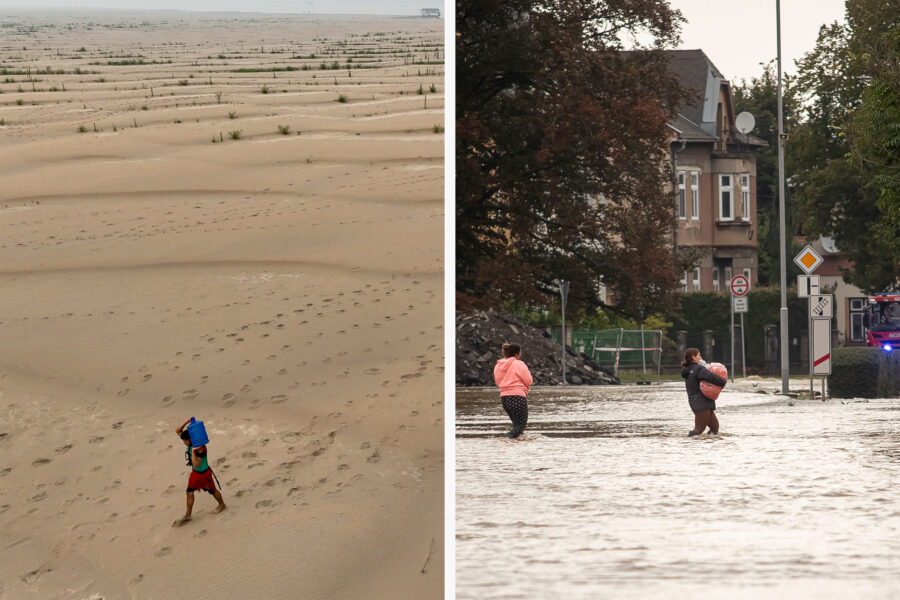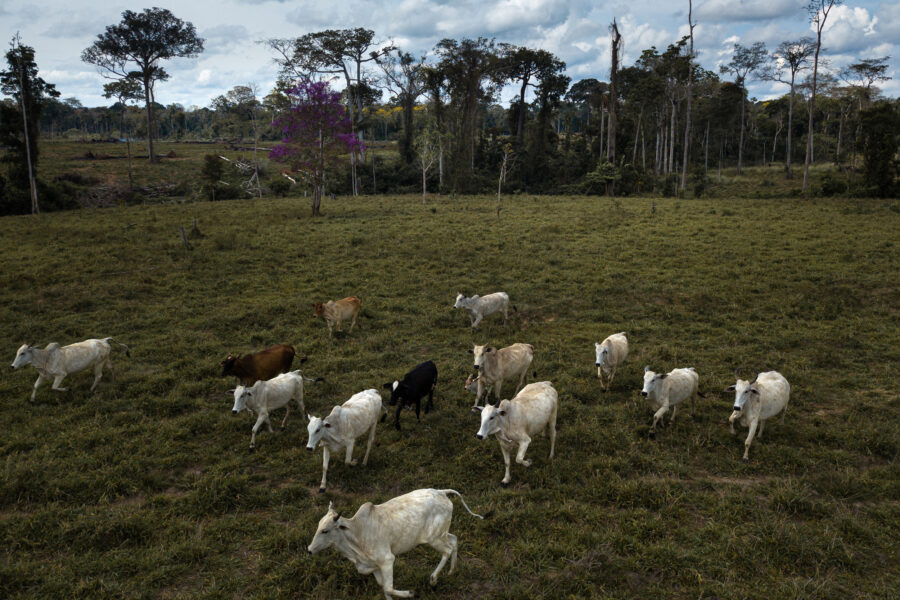With Wyoming’s Regional Haze Plan ‘Partially Rejected,’ Conservationists Await Agency’s Final Proposal
Every year, the 3.8 million people who visit Grand Teton National Park cross their fingers for clear skies. In perfect conditions, visitors can see the Tetons thrusting upward over serene mountain lakes, one of the most iconic views in the American West. But on hazy days, the mountains become grainy, their beauty dimmed by airborne fine particulate matter.
This phenomenon—expansive views obstructed by tiny particles in the air—is called “regional haze,” and the Environmental Protection Agency, under the authority of the Clean Air Act, requires states to reduce emissions from fossil fuel power plants to help clean up these viewsheds. In Wyoming, home to nine power plants that contribute to regional haze, the EPA last month partially approved and partially rejected the state’s most recent planning document for dealing with the haze after the state gave “unsubstantiated reasons for not requiring any additional emission reduction measures,” the agency said in its decision.
“They failed to evaluate emissions reductions for the oil and gas sector,” said Rob Joyce, chapter director of the Sierra Club in Wyoming. “They didn’t even evaluate pollution controls for the coal fired power plants.”
“Our concern apparently is shared by the EPA,” he said, “so we were happy to see that.”
Explore the latest news about what’s at stake for the climate during this election season.
The Sierra Club, the National Parks Conservation Association and Environmental Integrity Project have secured a consent decree with the EPA, which gives the agency court-mandated dates by which it must make final decisions regarding 32 states’ regional haze plans.
Wildfire smoke or large amounts of dust kicked up into the air can contribute to the accumulation of haze, but it is mainly caused by tiny particles generated by burning fossil fuels. As these pieces of pollution hang in the air, they can absorb and refract light, causing a veil of brown smog to appear in the air. Prolonged exposure to excess levels of particulate matter have been linked with irregular heartbeat, decreased lung function and numerous other health issues.
The EPA’s regional haze monitoring program, first announced in 1999, was born out of the federal government’s desire to ensure crystal clear vistas for visitors to 156 national parks and wilderness areas across the country—the vast majority of which are in the West. States, federal agencies and tribes all work together roughly every 10 years to develop updates to each state’s pollution control standards, the means by which each state ensures that they are in compliance with federal haze mandates.
“A lot of visitors go to these parks to see [natural beauty]. They get out of their cars for five minutes—they want to see the Grand Canyon in that five minutes,” said Natalie Levine, a campaign director at the National Parks Conservation Association. “The hazy days at parks and in communities happen all the time.”
Viewsheds’ vistas have diminished substantially in the decades since the country began mining, refining, fracking and burning fossil fuels. In the West, which has also experienced more frequent and intense wildfires, average visibility has gone from 140 miles to a range of 35 to 90 miles, according to the EPA. From the early 2000s to about 2015, the agency contends that states have made some improvements—much of Wyoming has gone from roughly 110 miles of visibility to about 130 in that stretch.
But visibility has still not fully recovered, and Wyoming’s pollution has impacts on views beyond Grand Teton and Yellowstone. The fossil fuel power plants in the Cowboy State are “huge contributors [to haze] not just in Wyoming but across the region,” said Levine. According to an analysis conducted by the National Parks Conservation Association using EPA data, Wyoming’s Jim Bridger Power Plant was at one point the “worst haze contributor in the country,” Levine said.
“A lot of visitors go to these parks to see [natural beauty]. They get out of their cars for five minutes—they want to see the Grand Canyon in that five minutes.”
PacifiCorp, which owns the Jim Bridger Power Plant, said in a statement to Inside Climate News that Wyoming’s regional haze plan was sufficient. “The Jim Bridger plant has two coal-fired units with state of the art emission control technology for haze reduction,” said Dave Eskelsen, a PacifiCorp spokesperson. Any suggestion that it is the worst haze contributor “is outdated,” he said.
The Wyoming Department of Environmental Quality did not return a request for comment for this story.
According to a Sierra Club analysis, Wyoming is home to the second—Bridger—seventh and eighth largest contributors to regional haze near national parks. The pollution from these plants is “not insignificant at all,” said Joyce, which is why the Sierra Club was so concerned by Wyoming’s emissions reduction plan, he continued.
In its regional haze plan submitted to the EPA, Wyoming repeatedly referenced a Trump-era guidance document, which did not require states to assess emissions from every source every 10 years. For many of its larger sources of emissions, Wyoming argued that recent retrofits were sufficient to tamp down emissions at the “uniform rate of progress needed to achieve the 2064 visibility end goals,” and installing new technology to reduce more emissions would be “economically infeasible.” Accordingly, the state reported that “no additional controls are necessary to make reasonable progress” on visibility requirements for six power plants, three soda ash plants and a cement facility. One gas-fired power plant and a fertilizer facility warranted “further analysis of emission controls to reach reasonable progress,” the state said.
PacifiCorp’s power plants in Wyoming “have fully effective controls for most emissions and are making significant strides in reducing emissions during this planning period that are more than the state or EPA could require under the regional haze program alone,” said Eskelsen.
Conservationists are hoping the EPA plays a more active role in determining what the state’s pollution controls look like moving forward.
“What we’re asking them to do is to finalize that decision and go on to the next process. Instead of kicking it out back to the state and saying, ‘do better, give us another plan,’ just move into what’s called a federal implementation plan,” said Joyce. Under such a plan, the EPA would determine how emissions from Wyoming’s fossil fuel power plants are controlled.
In its public comment to the EPA, the National Parks Conservation Association asked for the same thing. Levin would not speculate as to whether a federal plan would survive an administration change in 2025, but she noted that any decision made about Wyoming’s plan by the EPA, which must issue one this year, is binding. The state—and industry—could still sue, she said, but barring a loss in court, Wyoming would have to take steps to implement pollution controls regardless of who’s in the White House.
With the public comment period concluded, the EPA has until Nov. 22 to issue its final decision regarding Wyoming’s regional haze plans.
About This Story
Perhaps you noticed: This story, like all the news we publish, is free to read. That’s because Inside Climate News is a 501c3 nonprofit organization. We do not charge a subscription fee, lock our news behind a paywall, or clutter our website with ads. We make our news on climate and the environment freely available to you and anyone who wants it.
That’s not all. We also share our news for free with scores of other media organizations around the country. Many of them can’t afford to do environmental journalism of their own. We’ve built bureaus from coast to coast to report local stories, collaborate with local newsrooms and co-publish articles so that this vital work is shared as widely as possible.
Two of us launched ICN in 2007. Six years later we earned a Pulitzer Prize for National Reporting, and now we run the oldest and largest dedicated climate newsroom in the nation. We tell the story in all its complexity. We hold polluters accountable. We expose environmental injustice. We debunk misinformation. We scrutinize solutions and inspire action.
Donations from readers like you fund every aspect of what we do. If you don’t already, will you support our ongoing work, our reporting on the biggest crisis facing our planet, and help us reach even more readers in more places?
Please take a moment to make a tax-deductible donation. Every one of them makes a difference.
Thank you,
David Sassoon
Founder and Publisher
Vernon Loeb
Executive Editor
Share this article
Disclaimer: The copyright of this article belongs to the original author. Reposting this article is solely for the purpose of information dissemination and does not constitute any investment advice. If there is any infringement, please contact us immediately. We will make corrections or deletions as necessary. Thank you.








